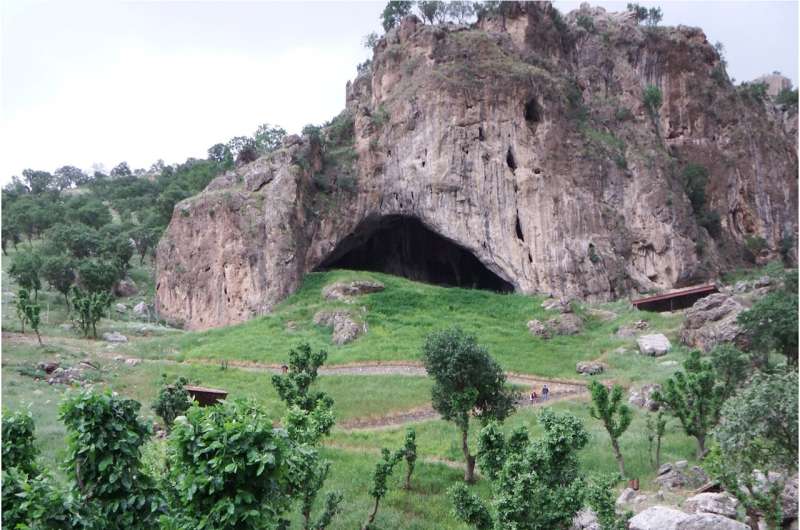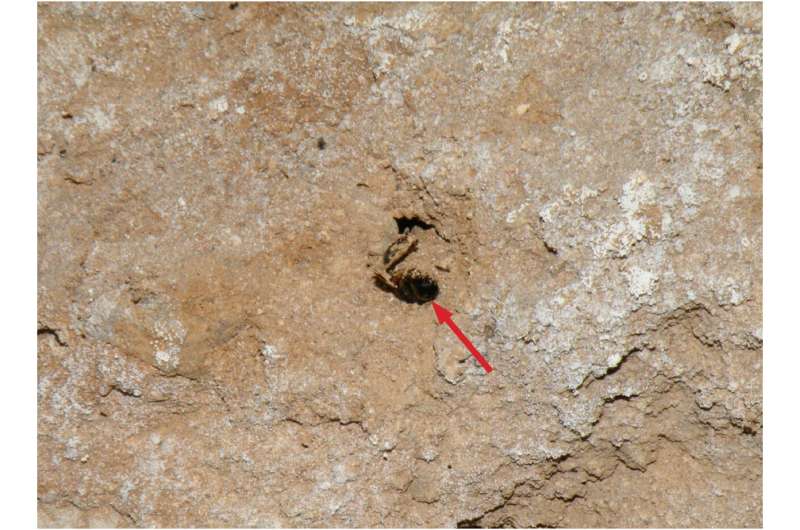August 31, 2023 report
This article has been reviewed according to Science X's editorial process and policies. Editors have highlighted the following attributes while ensuring the content's credibility:
fact-checked
peer-reviewed publication
trusted source
proofread
How ancient bee burrows led to a better understanding of Neanderthals

The Shanidar cave sits in the Zagros mountains of the Kurdish autonomous region of Iraq, in a border region between Iran and southeast Türkiye. Within the cave is one of the longest-debated collections of Neanderthal remains.
Researchers at Liverpool John Moores University, the University of Cambridge, and the University of London collaborated to reinvestigate one of the site's most debated findings, the "Flower Burial." Pollen found in a Neanderthal burial has been previously hypothesized to be evidence of a floral grave offering.
In a paper, "Shanidar et ses fleurs? Reflections on the palynology of the Neanderthal 'Flower Burial' hypothesis," published in the Journal of Archaeological Science, the team lays out the case for the pollen found in the grave sites being of non-human placement, likely by bees.
Through his excavations in Shanidar Cave in the 1950s and 1960s, Ralph Solecki put forward the "Flower Burial" hypothesis. According to this hypothesis, the Neanderthal known as Shanidar 4 was placed on a bed of flowers, possibly for medical reasons, as a mark of affection, or as a sign of respect.
This hypothesis had a transformative impact on the understanding of Neanderthals, challenging their previous characterizations as entirely brutish and suggesting they were capable of empathy and care.
The discovery of pollen in the burial pits suggested the possibility of funerary offerings to Solecki. He notes that some of the local workers liked to wear flowers on their belts and that the pollen could have arrived by way of the excavation team, though this was eventually ruled out.
Based on previous illustrations by French archaeologist Arlette Leroi-Gourhan of the pollen around the Shanidar 4 Neanderthal showing flattening and corrosion, consistent with it being ancient, the researchers discount the possibility that Solecki and his colleagues introduced the pollen. Instead, they conclude that the pollen is likely to be approximately contemporary with the Neanderthal with which it is associated.
Mystery solved
The analysis concludes that the presence of taxonomically mixed clumps is inconsistent with the clumps of pollen from the deposition of whole flowers. Instead, the researchers suggest it is far more likely that the taxonomically mixed pollen was collected and deposited by bees.
The burrows of solitary bees can be found in less-trampled areas of the cave floor today. Individual bees can collect multiple floral pollen species as they forage, and their burrows are common to the cave, making them an ideal suspect for the pollen clumps.
Most burrows are described as sub-vertical to vertical and shallow (<5 cm), with some being more than 0.5 m deep and 6–8 mm in diameter. The bullet-shaped linings are highly durable, and current researchers detected ancient burrow linings in their excavations, confirming an ancient bee presence.
Older burrows tend to have a sandy, ashy fill, which is more challenging to see. With careful observation (and artificial lighting), textural differences from the host sediment can be seen as they cut through stratification.
The authors note that the area in which Shanidar 4 and associated skeletal remains were found had been left open for more than a year before excavation started, opening the possibility that the pollen clumps were introduced by bees just before Solecki's excavation.
As these would have been more noticeable to the original excavation than ancient bee burrows in the dig site, it is perhaps more likely that bees were nesting in the sediments around Shanidar 4 shortly after burial.
Under modern conditions, the flowers represented in the Shanidar 4 pollen cannot all be collected simultaneously in any season, ruling out the excavation team and flowers being gathered immediately at the time of death. Bees could easily have deposited the pollen throughout a growing season.

Solved?
On the other hand, Leroi-Gourhan's suggestion that some clumps contained immature pollen might suggest more complex scenarios. Some questions are still to be resolved.
Researchers still need to clarify or establish why clumps of pollen were only recovered from three samples associated with Neanderthal remains out of the 21 samples containing pollen analyzed from the cave by Leroi-Gourhan. The possibility of other mechanisms, such as small mammals or Neanderthal activities, according to the researchers, cannot be completely ruled out.
Unexplained wood fragments found within the grave dirt of Shanidar Z, a more recently discovered Neanderthal skeleton that significantly overlaps with the Shanidar 4 site, suggests there is still more funerary mystery left in the cave.
Back to the beginning
Solecki's original conclusions, as outlined in his hypothesis, proposed a scenario where Neanderthals displayed complex behavior related to the care of their dead, such as burial and funerary offerings, which was quite different from earlier perceptions of Neanderthals as primitive, less advanced or even savage beings.
His original conclusions have been debated and scrutinized by subsequent researchers, often questioning whether the remains were purposefully placed and buried. With various alternative explanations and criticisms being put forward over the years, the burial hypothesis still stands as more supporting evidence for intentional burial has been discovered.
There are also Neanderthal remains found in Shanidar Cave, specifically Shanidar 1, with evidence of having likely received lifelong care. Shanidar 1, a male Neanderthal, had a severe head injury that may have left him blind in his left eye while partially paralyzing his right arm and leg.
Researchers have previously suggested that the fact that Shanidar 1 survived for an extended period with these injuries is indicative of him receiving care and support from other Neanderthal group members. This can be seen as evidence of compassion and cooperation within Neanderthal communities.
Even if the Shanidar cave pollen turns out to be from bee activity, taking on the possibility of an intellectually complex Neanderthal was the correct choice.
In the years since the original discovery, Neanderthals at other locations have been discovered to be responsible for cave paintings and etchings, carved wooden throwing spears, jewelry fashioned from eagle talons, and beads made from bone, shell, and ivory.
Neanderthals also collected decorative conches from faraway beaches, arranged large animal skulls around fire hearths, crafted fire-making kits, distilled birch tar into a synthetic adhesive, and were charming enough to interbreed with the ancestors of most current modern humans.
Depositing a few flowers in a gravesite no longer seems beyond the pale of Neanderthal behavioral complexity. Solecki's clear-eyed "Flower Burial" hypothesis may be responsible for the shift in thinking that allowed for the unbiased assessments of many other sites and a better understanding of our inner Neanderthal cousins.
More information: Chris O. Hunt et al, Shanidar et ses fleurs? Reflections on the palynology of the Neanderthal 'Flower Burial' hypothesis, Journal of Archaeological Science (2023). DOI: 10.1016/j.jas.2023.105822
Journal information: Journal of Archaeological Science
© 2023 Science X Network


















